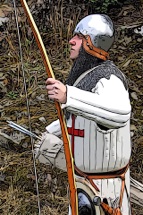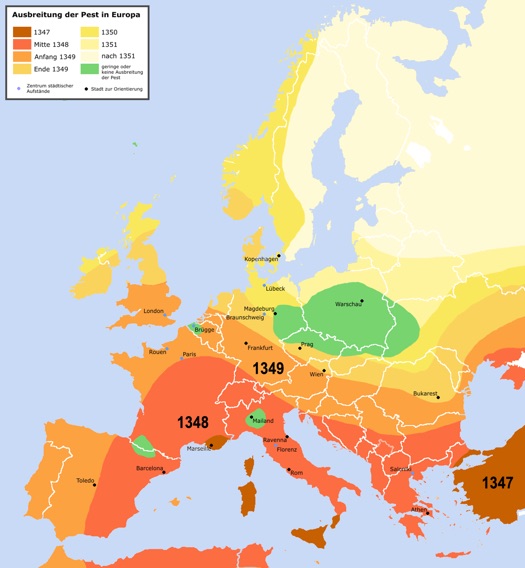Black death (plague)
The Black Death is one of the most devastating pandemics in world history, causing an estimated 25 million deaths in Europe between 1346 and 1353, in the middle of the Hundred Years' War - one third of the population at that time. On the map you can see that the corresponding area for our investigation - England and France - was affected at the beginning of 1349 (orange).
Roger_Zenner, Pestilence spreading 1347-1351 europe, CC BY-SA 2.0 DE
The cause is considered to be the plague caused by the bacterium Yersinia pestis. The word plague is derived from the Latin word pestis for pestilence and is therefore also used without a direct reference to the disease plague. According to current knowledge, the pandemic first appeared in Central Asia and reached Europe via trade routes (including the Silk Road). From the Eastern Mediterranean, the disease probably spread to the rest of Europe via rat fleas, but some areas remain relatively unaffected.
Social impacts
The social impact of the Black Death was very far-reaching: the Jews were accused of having caused the pandemic by poisoning and poisoning wells. This led to Jewish pogroms in many parts of Europe and the extermination of Jewish communities.
The term "Black Death
The term "Black Death" (mors nigra) was not used specifically for the plague in the Middle Ages - contemporary chroniclers spoke of the "great dying" (mortalitas magna) or the "great pestilence" (pesti magna).
Current research
The trend in recent research suggests that rather 45-50% of the European population died over a four-year period. There are considerable geographical differences. In the Mediterranean regions of Europe, areas such as Italy, southern France and Spain, where the plague raged for four years, around 75-80% of the population probably died. In Germany and England ... the death rate was probably closer to 20%.
Port town Kaffa - starting point of the plague in 1346
In the year of the Lord 1346 - the year in which Edward III of England defeated the army of the French King Philip VI at Crécy - the Tartar leader Jani Beg attacked the port city of Kaffa on the Kram peninsula on the Black Sea. The Tartar Khan led a huge army from the vastness of the steppe in front of the town and enclosed it. Kaffa was a heavily fortified Genoese trading base and the Tartars could not take the city walls by storm. The Genoese supplied the city from the sea, and so they could defend the besiegers for months.
While the siege continued, a plague broke out in the army of Jani Bag, which had reached the steppes north of the Black Sea from Central Asia along the Silk Road. Every day thousands of his warriors died and it seemed as if the Khan would have to break off the siege. To force the defenders to give up, the Tartars catapulted the bodies of those who had died of the plague over the city walls. This was not an unusual procedure. Christian armies also occasionally hurled the rotten corpses of people and animals into besieged cities to bring epidemics to a head.
In Kaffa the disease spread at an uncanny speed. The people fell ill and died so quickly in such masses that the defenders had no choice but to abandon the city, they boarded their ships and fled to Constantinople and on to Italy. They took the disease with them.
The Florentine Giovanni Boccaccio described the speed with which death came most aptly when he noted that many of the victims "took their lunch with their friends and their dinner with their ancestors in paradise".
Long-term effects of the Black Death
In the long term, the disease caused and accelerated a profound change in medieval European society. As David Herlihy shows, the generations after 1348 could not simply maintain the social and cultural patterns of the 13th century. The massive population decline led to a restructuring of society, which had a positive long-term impact. Thus Herlihy calls the pandemic "the hour of the new men": depopulation gave a larger percentage of the population access to farms and worthwhile jobs.
The guilds were now admitting members who had previously been refused admission. While the market for farm rents collapsed, wages in the cities rose significantly. As a result, a larger number of people could afford a higher standard of living than ever before, but food shortages also occurred in some cases because many fields were no longer farmed, for example in England, where wages for farm workers rose sharply. Although in 1349 the nobles enforced the "Statute of Labourers" in parliament, which limited the wages for field work, the agricultural workers were additionally paid in kind. The wage disputes eventually led to the great peasant uprising of 1381, the "Peasants' Revolt", in the wake of which England became the first country in Europe to abolish serfdom. Free farmers were replaced by tenants, and less labour-intensive sheep farming replaced agriculture.
Impact of the plague on the Hundred Years War
The severe economic and social crisis triggered by the plague affected the whole of Europe and therefore had an impact on the course of the war only to the extent that the following operations took place at a time of severe population decline. The resulting shortage of labour affected the war between the kings of England and France in such a way that it was only brought to a standstill, but not ended.
Sources
https://de.wikipedia.org/wiki/Pest
https://de.wikipedia.org/wiki/Schwarzer_Tod
Der Hundertjährige Krieg, Joachim Ehlers, ISBN 978-3-406-56275-4, Seite 28
Der Schwarze Prinz und die Schlacht bei Poitiers, Dr. Johann Baier, ISBN 978-3-938921-29-6, Seiten 43-51

























